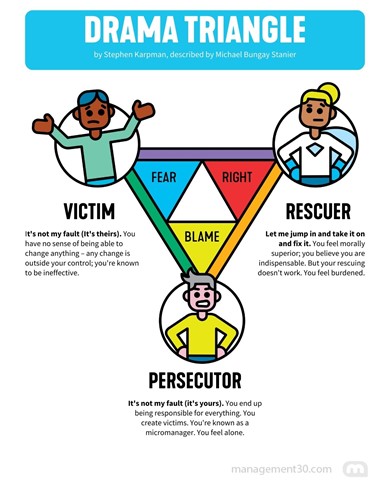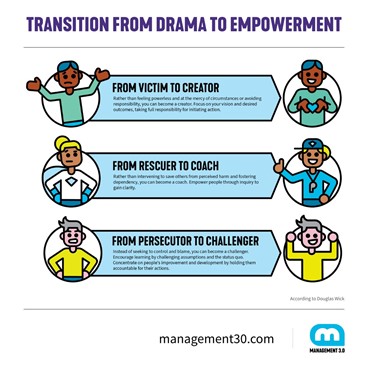An explanation of the drama triangle and the importance of understanding it in leading teams:

The Karpman Triangle, also known as the Drama Triangle, is a psychological framework that describes dysfunctional and destructive interpersonal dynamics. Developed by psychologist Stephen Karpman, the triangle represents three primary roles that people take on in conflict situations: victim, harasser, and rescuer.
In leadership, these roles can hinder team collaboration and growth. It is critical for leaders to understand the importance of the Drama Triangle in preventing conflict, micromanagement, and burnout. Strategies include addressing triggers, fostering open communication, and fostering emotional intelligence.
As a manager, you will encounter conflict on your team. These conflicts often involve three key roles: victim, harasser, and rescuer, which together create the Drama Triangle. People often shift between these roles unintentionally. By understanding the drama triangle, you can identify these patterns, resolve conflicts, and work toward empowering your teams.
The Three Roles of the Drama Triangle
First described in the 1960s by Steven Karpman, an American therapist and one of the founders of interactional behavior analysis, the drama triangle identifies three main roles: the victim, who feels oppressed and helpless; the abuser, who blames and criticizes; and the rescuer, who tries to solve the victim’s problems but often becomes codependent. These roles are not fixed. People can shift between them in different situations. Understanding these roles provides essential insight into the dynamics of conflict and helps identify patterns of behavior in teams and organizations.
Award-winning author, coach, and speaker Michael Bangay Stanier describes these roles in his book The Coaching Habit:
 |  |  | |
| Victim | Annoying | Savior | |
| Core belief | “My life is so hard. My life is so unfair, poor me.” | “I am surrounded by fools, or people less than me.” | “Don’t fight, don’t worry, let me come and fix it.” |
| Stimulus | It’s not my fault (it’s their fault) | It’s not my fault (it’s your fault) | “This is my responsibility (not yours)” |
| Benefits of playing this role | You have no responsibility for fixing anything: you have to complain. You call the repairmen. | You feel superior and have a sense of power and control. | You feel morally superior. You believe you are indispensable. |
| The cost of playing a role | You have no sense of being able to change anything – any change is beyond your control. You are known for being ineffective and no one likes a whiner. | Ultimately, you are responsible for everything. You make the sacrifice. You are known as a detail-oriented manager. People do the bare minimum for you and no more. And nobody likes a bully. | People will reject your help. You’re creating a victim and perpetuating the drama triangle. And no one likes an interloper. |
| You feel like you’ve reached a dead end because | You have no power or influence. You feel useless. | You don’t trust anyone. You feel lonely. | Your salvation is not working. You feel like a burden. |
To break free from this cycle, it is important to understand why drama triangles form.
What causes drama triangles?
Drama triangles often stem from unmet emotional needs, a lack of assertiveness or self-awareness, and poor communication skills. In addition, the team or organizational culture can reinforce them. A culture of blame, fear, or unresolved conflict and conflict encourages drama triangles and highlights situations where psychological safety is lacking.
Drama Triangle in Leadership
In leadership, the drama triangle manifests itself in toxic behaviors such as blaming, avoiding responsibility, and micromanaging. Leaders who are placed in the victim role feel overwhelmed by challenges. In the harasser role, they resort to authoritarian tactics, and in the rescuer role, they micromanage their team to “save” them. This behavior hinders team growth, innovation, and collaboration.
When leaders find themselves caught in the role of savior and constantly taking on more responsibility than their team, it can lead to frustration, fatigue, and in extreme cases, burnout. Therefore, it is essential to set clear expectations and boundaries for your team and delegate tasks transparently, a skill you can acquire through an agile team leadership workshop.

Understanding the Drama Triangle is crucial for leaders because it directly impacts team dynamics, communication, and overall productivity in the workplace.
Conflict Resolution: The Drama Triangle highlights common conflict patterns and allows leaders to more effectively identify and address conflicts. By understanding the roles of victim, abuser, and rescuer, leaders can guide their teams toward healthy conflict resolution and prevent conflicts from escalating.
Team Collaboration: The Drama Triangle can hinder team collaboration and cohesion. Leaders who understand these dynamics can work to create a more harmonious and collaborative work environment and foster better teamwork and synergy among team members.
Empowering Teams: Breaking free from the Drama Triangle allows leaders to empower their teams. When team members no longer feel victimized, persecuted, or rescued, they become more autonomous, take responsibility, and collaborate more actively.
The effect of the drum triangle:

Triggers and Anticipating Drama Triangle Dynamics
Leaders should be aware of the triggers that can lead to drama triangle dynamics in their teams. These triggers may include stressful situations, disagreements, changes in the workplace, or personal challenges among team members.
By recognizing these triggers, leaders can anticipate potential drama triangle dynamics and take proactive steps to address them before they occur. Anticipating these dynamics requires understanding the unique dynamics and personalities within the team, which allows leaders to tailor their communication and management strategies to prevent the drama triangle from taking hold.
Additionally, creating an environment where team members feel safe to talk about their concerns and seek solutions can help reduce triggers and create a more harmonious workplace.
How do you break the drama triangle?
Understanding the underlying causes is crucial to effectively addressing this issue. By acknowledging these causes, leaders can work toward creating a healthier workplace. But how do you break free from the drama triangle?
Breaking free from the drama triangle requires self-awareness, effective communication, and empathy. As a leader, you can learn these skills, develop habits to remind yourself to use them, and create a system that fosters psychological safety and helps others escape the drama triangle.
Remember: Manage the system, not the people!
As a leader, you can create a system that encourages open dialogue and promotes a blame-free culture. Offering conflict resolution training is a great way to do this. These workshops will allow you to learn about emotional intelligence and better understand your team members.
By implementing these strategies, you can empower your team members to voice their concerns, take responsibility, and proactively collaborate, breaking the destructive cycle of the drama triangle.
Remember that discussing concerns shouldn’t be limited to specific, retrospective events, but should become a daily habit, just like giving praise or providing one-on-one feedback.
Nonviolent Communication (NVC[1]) is an effective tool for breaking the drama triangle by promoting empathy, active listening, and constructive communication. NVC encourages people to express their feelings and needs without blaming or judging, and it fosters understanding and connection. Rather than blaming or rescuing, NVC empowers people to express their needs, which leads to more empathetic and mutually beneficial solutions. By practicing NVC, teams and leaders can create a more harmonious work environment and break free from the destructive dynamics of the drama triangle.
[1] Nonviolent Communication (NVC)
Escaping the Drama Triangle as a Leader
When leaders were asked if they recognized the drama triangle and what role they claimed for themselves, most leaders cited the role of rescuer. In particular, leaders who are trying to protect their team or reduce their own mental burden often fall into this role. But how can you break free from this role and prevent the drama from continuing?
Here, it’s useful to mention another valuable tip from Michael B. Stenner[1]: Ask a specific question rather than offering immediate help. Ask: How can I help? This question may seem simple, and it is—but you have to remember to ask it.
Aside from remembering the question, what are the benefits of this approach?
First, it forces the victim to make a concrete request. This request will be specific and will allow you to decide whether you want to help or not.
Second, and more importantly, it avoids assuming that you know the best solution. This helps you better understand the situation and the other party, and fosters curiosity and active listening. Often, a concrete request will reveal different perspectives and alternative solutions.
However, be mindful of the timing and tone when using a more assertive version of the question, such as “What exactly do you want from me?” as it may trigger additional emotions.
Transitioning from the Drama Triangle to Empowerment
As you can see, conflict and the Drama Triangle are inevitable, but you can learn to move past it and shift from drama to empowerment.
[1] Michael B. Stanier
From Victim to Creator
Instead of feeling powerless and overwhelmed by circumstances or avoiding responsibility, you can become a creator. Focus on your vision and desired outcomes, and take full responsibility for initiating action.
From Bully to Challenger
Instead of seeking control and blame, you can become a competitor. Encourage learning by challenging assumptions and the status quo. Focus on improving and developing people by holding them accountable for their actions.
From Rescuer to Coach
Understanding the Drama Triangle is essential for agile leaders. By understanding the roles, causes, and manifestations of the Drama Triangle, leaders can eliminate its destructive impact and begin to build a system characterized by harmonious collaboration, respectful communication, and empowered teams.
Thus, leaders can learn to avoid common pitfalls, escape the Drama Triangle, protect themselves, and become respected and successful leaders.
